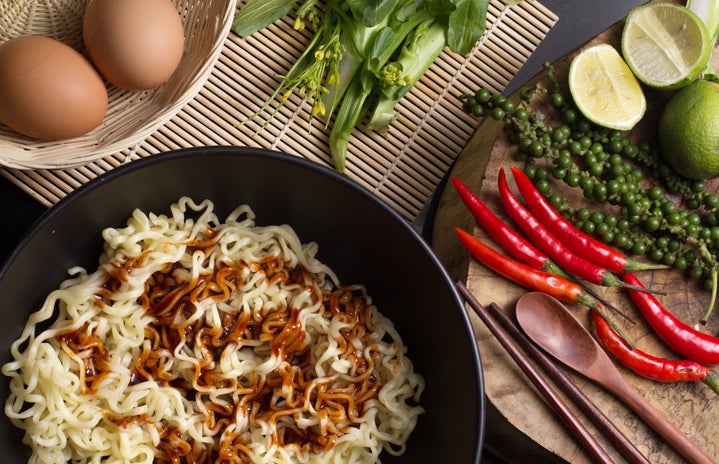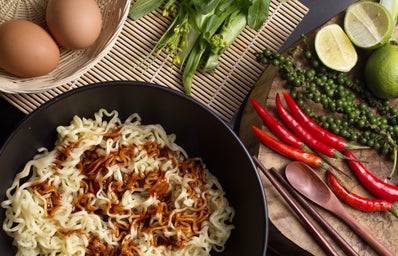Everyone has their good luck charms. From pre-game rituals, to pump-up playlists, to rewatching favorite movies—we all use different methods to get in the zone. As for me, well, before every big exam, I make a bowl of my lucky ramen.
I know, I know. I’m a college student. Isn’t ramen like, an every day staple of my diet?

While I am guilty of eating a lot of noodles and pasta on an almost daily basis, I like to save this ramen for special occasions or when I just need a pick-me-up. When I was younger, my parents would make this for me when I had a bad day, or was tired, or was really craving some ramen, so there are a lot of good feelings associated with this dish. Also, it was the first thing I learned how to make, so we can pinpoint this meal as the start of my culinary career. (Just kidding… I hate cooking). But that’s the beauty of this dish—if I can make it taste good, anyone can.
The ramen I use is Nongshim Shin Ramyun ramen, and it comes in individually wrapped packets with noodles, a vegetable mix, and a spicy soup base (more on this later). You can find this at most grocery stores, though my family buys it from our local Asian supermarket in a box of 18.
I also add a poached egg and bok choy for extra protein and nutrients. If you’ve never had bok choy before, it’s a leafy green vegetable whose top half resembles a spinach leaf and whose bottom half is somewhat cabbage-like. It’s a staple in most Asian dishes, like lo mein, stir fry, ramen, or just on its own, because of its versatility.

Got all the ingredients? Sweet. Let’s get cooking.
I like to make the egg first, because I use the same water from poaching the egg to cook the ramen. Here is a good recipe/technique for how to successfully poach an egg (I’m still not great at it, but my eggs turn out edible, which is all that really matters!) Once you’ve finished the egg, haul it out of the pot with a slotted spoon and set it aside.
The ramen can just be cooked like any other pasta: boil some water, plop the brick of noodles and the vegetable mix in the pot, let it reach the desired texture, and voila!
Here’s the fun part. Remember that spicy soup base I mentioned earlier? This is what gives the ramen that extra spicy flavor that I love. Depending on your spice tolerance, you can add as much or as little as you like. (Fair warning, though: I handle spice well, and I’ve never added the entire packet, so this stuff is pretty hot.) In order to let the flavor soak into the noodles, I add the spice toward the beginning, when the ramen brick is just soft enough to separate into individual noodles.

As with most ramen, the noodles are done pretty quickly: I’d say it takes less than 10 minutes to reach a good texture. I add the bok choy just before the noodles are done, which gives it enough time to cook and soak in some of that ramen soup flavor as well.
When I’m satisfied with the consistency of the noodles, I let it cool down on the stove top for a couple of minutes before pouring everything—soup and all—into a bowl. Add in the poached egg from before, and your dish is halfway to looking like gourmet restaurant ramen!
The whole process, from cooking the egg to plating the ramen, takes about 15 minutes in all. Perfect for those busy exam days when I’m trying to cram every last bit of studying I can into the minutes before I take the test.

Now, the question we’ve all been wondering: does eating this ramen before tests actually help me do better on exams? Honestly, I have no idea. What I do know is that it puts me in a good mood and brings up fun memories with my family. So whether or not it’s actually a good luck talisman, the fact that it puts a smile on my face is enough for me.
P.S. this article is not sponsored, but @Shin Ramyum if you are reading this I would love some free ramen. :-)



